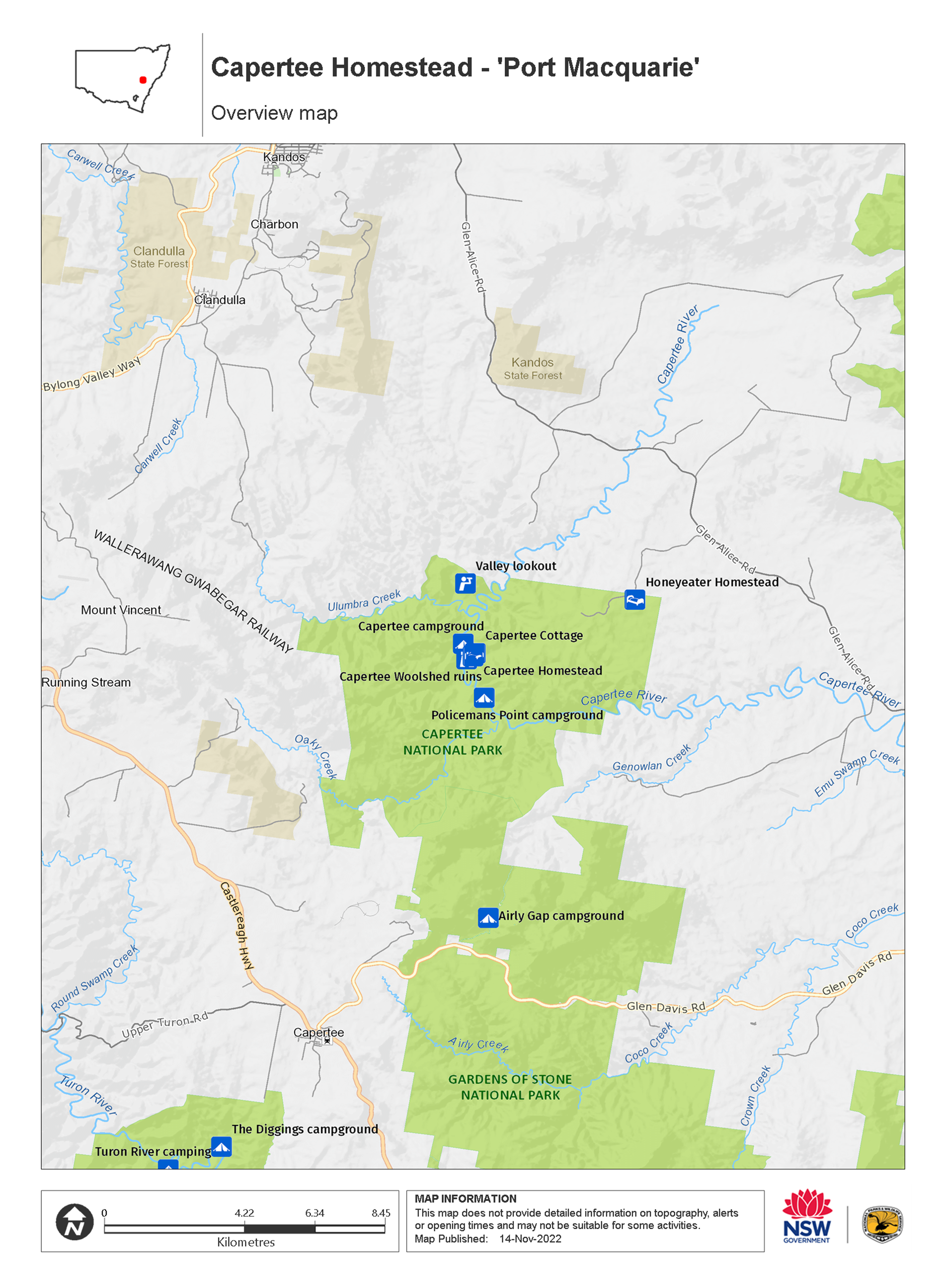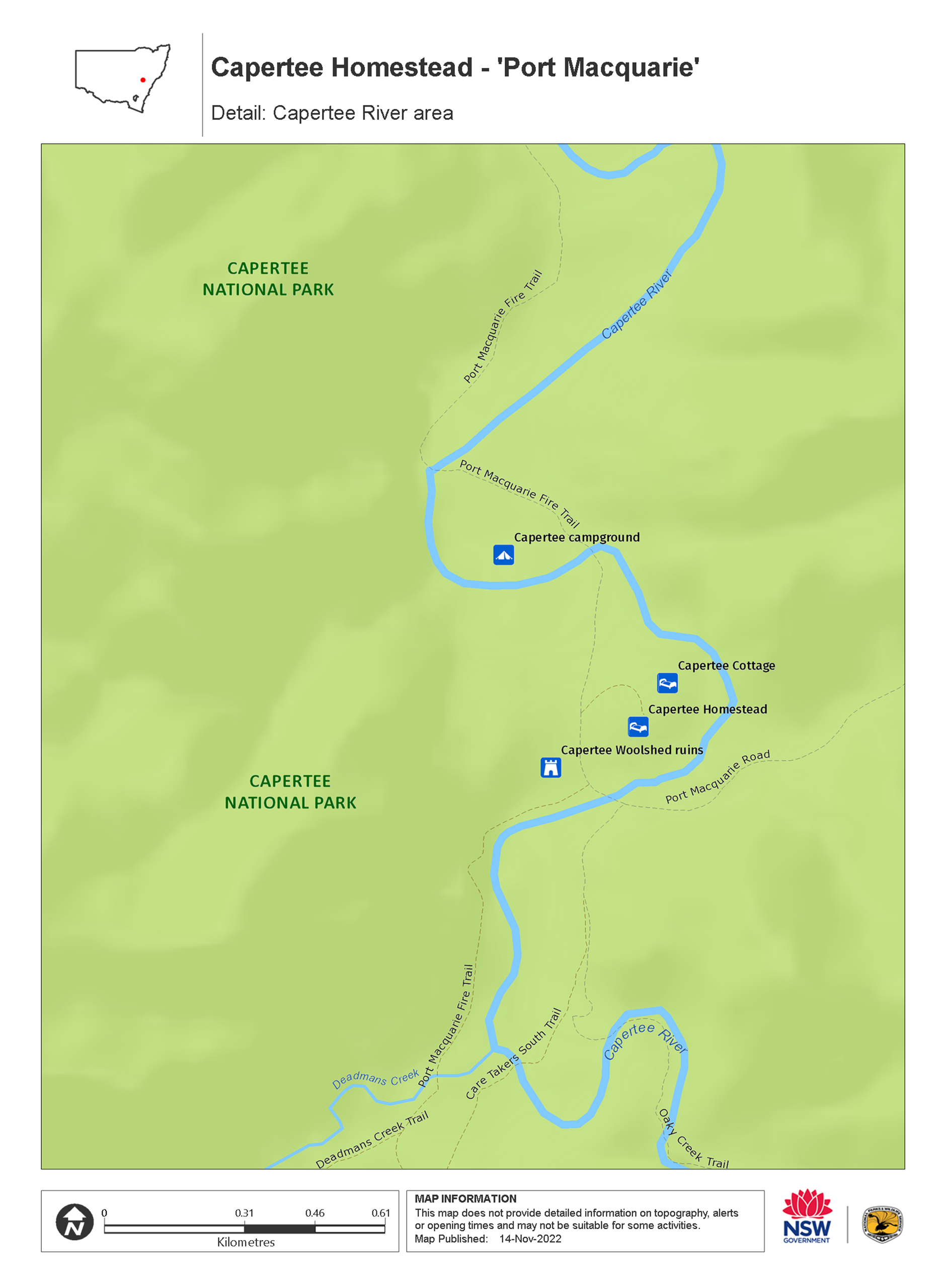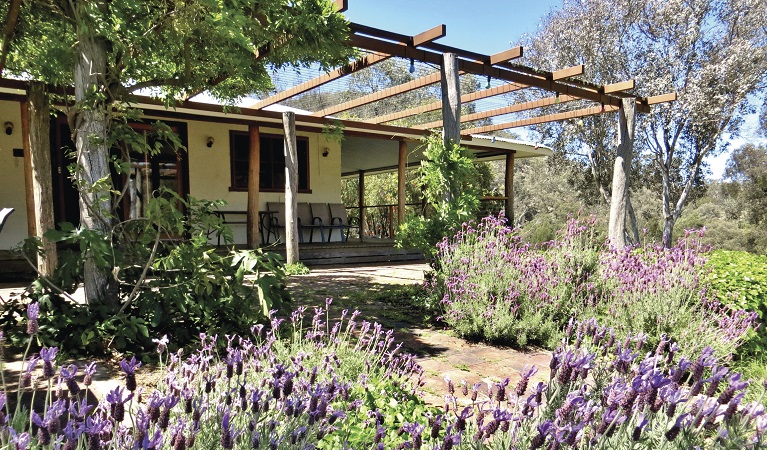Capertee Homestead - 'Port Macquarie'
Capertee National Park
Open, check current alerts
Overview
The historic Capertee Homestead, known as 'Port Macquarie', is a great weekend getaway in Capertee National Park. Go birdwatching, mountain biking, 4WD touring and walking.
| Accommodation type | Homestead |
|---|---|
| Where | 1046 Port Macquarie Road, Bogee, NSW, 2849 - in Capertee National Park |
| Bedrooms | 4 |
| Maximum guests | 14 |
| Facilities | Toilets, showers, barbecue facilities, balcony, outdoor furniture, indoor fireplace, kitchen, plates and cutlery, bed linen, air conditioning, tv, towels, washing machine, electric power, rubbish bin |
| What to bring | Drinking water, cooking water, food supplies |
| Please note |
|
Capertee Homestead (named 'Port Macquarie') is an inspiring historic building originally built in the 1920s overlooking the river in Capertee National Park, north of Lithgow.
There's plenty of space in Capertee Homestead, with charming country style accommodation for large groups or families who want to experience a unique weekend getaway.
Early mornings and dusk are a great time to spot wallabies, wombats and kangaroos. Explore the surrounding bush on a range of walks and enjoy a picnic by the river. When it’s time to cool off, enjoy a refreshing paddle in the shallow waters.
If you want to relax, simply find a shady spot on the wrap-around verandah and enjoy some birdwatching. Gather your family and friends around in the evening and take advantage of your surroundings with a barbecue before heading inside and settling in around the slow combustion fire.
Map

Map legend

Map

Local alerts
For the latest updates on fires, closures and other alerts in this area, see https://www.nationalparks.nsw.gov.au/camping-and-accommodation/accommodation/capertee-homestead-port-macquarie/local-alerts
Bookings
- National Parks Contact Centre
- 7am to 7pm daily
- 1300 072 757 (13000 PARKS) for the cost of a local call within Australia excluding mobiles
- parks.info@environment.nsw.gov.au
Operated by
- Mudgee office
- Monday to Friday, 9am to 4:30pm.
- 02 6370 9000
- npws.mudgee@environment.nsw.gov.au
- 27 Inglis Street, Mudgee NSW 2850
Park info
- in Capertee National Park in the Sydney and surrounds and Country NSW regions
Capertee National Park has a locked entry gate. If you're visiting during the day, get the gate code by calling Mudgee Office (weekdays) or Blue Mountains Heritage Centre (weekends).
Visitor info
All the practical information you need to know about Capertee Homestead - 'Port Macquarie'.
Getting there and parking
Capertee Homestead is in the northern part of Capertee National Park. To get there:
- Turn on to Port Macquarie Road (unsealed) from Glen Alice Road
- From the locked gate on the park boundary, follow Port Macquarie Road for 5km
- Upon arriving at Capertee River causeway, cross the river and take the road on the right to the cottage and homestead
Important: Follow the instructions and the map provided by NPWS. Don't use Google maps or GPS as this will give you an incorrect route and you may not be able to access the property.
After booking you'll get a code to open the park boundary gate and a door code to access the cottage. Contact 1300 072 757 if you have not received your codes.
Road quality
Please be aware that the homestead is accessed by crossing Capertee River via a causeway. At times of very heavy rain, flooding may occur, preventing access to and from the homestead. Check the weather before you set out or contact Mudgee office.
- Unsealed roads
Vehicle access
- 2WD vehicles
Weather restrictions
- All weather
Parking
Parking is available at Capertee Homestead.
Best times to visit
There are lots of great things waiting for you in Capertee National Park. Here are some of the highlights.
Autumn
The cooler autumn months are an excellent time for walking and mountain biking the trails and tracks within the park.
Spring
Grab your binoculars for some superb birdwatching. You might catch a rare glimpse of the endangered regent honeyeater as it builds its nest.
Summer
Enjoy a relaxing picnic on the shady banks of Capertee River.
Winter
Enjoy a car tour of Capertee while taking in nearby Wollemi and Goulburn River National Parks.
Facilities
- The homestead is fully furnished with 4 bedrooms, a separate external bedroom, kitchen, dining room, living room and 2 bathrooms with showers and toilets.
- Sleeps 10 people in 4 bedrooms: 1 Queen bed and 1 single bed, 1 Queen bed, 1 Queen bed and 1 single bed, and 2 single beds.
- The separate external bedroom sleeps 4 people: 1 double bed and 2 single beds. There is a heater in this room.
- You need to bring water for drinking and cooking. Hot and cold water suitable for washing and showering is provided.
- Please leave the homestead clean and tidy and report any breakages, damage or maintenance issues to the Mudgee office.
Toilets
- Flush toilets
Showers
- Hot showers
Barbecue facilities
- Gas/electric barbecues (free)
Balcony
There's a wrap-around verandah.
Outdoor furniture
Indoor fireplace
The living room has a wood fire heater. We provide 1 small bag of firewood and 1 small bag of kindling for the wood fire heater.
Kitchen
The kitchen has a fridge and freezer, gas oven, toaster, kettle, dishwasher, crockery, cutlery, glassware and tea towels.
Plates and cutlery
Bed linen
Bed linen, towels, duvets and pillows are provided.
Air conditioning
Ducted air conditioning
TV
There's a TV and DVD player but no TV reception.
Towels
Washing machine
Includes external clothes line.
Electric power
This property is connected to mains power.
Rubbish bin
Please recycle rubbish into appropriate bins.
Maps and downloads
Accessibility
Disability access level - no wheelchair access
Prohibited
Drones
Flying a drone for recreational purposes is prohibited in this area. Drones may affect public enjoyment, safety and privacy, interfere with park operations, or pose a threat to wildlife. See the Drones in Parks policy.
This area may be a declared Drone Exclusion Zone, or may be subject to Civil Aviation Safety Authority (CASA) rules for flying near airports, aerodromes and helicopter landing sites. See CASA's Drone Flyer Rules.
Commercial filming and photography
Commercial filming or photography is prohibited without prior consent. You must apply for permission and contact the local office.
Learn more
Capertee Homestead - 'Port Macquarie' is in Capertee National Park. Here are just some of the reasons why this park is special:
Looking for things to do in Capertee?

There are great things to do when in Capertee. Enjoy fantastic bird watching any time of the year - the protected woodlands attract the threatened gang-gang and glossy black cockatoos, and Capertee Valley is one of only three known nesting areas for the endangered regent honeyeater. You'll find a range of options if you're looking for a place to stay, including Capertee Homestead, Cottage or campground. Bookings essential. You can also hike into remote Policemans Point campground.
- Capertee Woolshed ruins Capertee Woolshed ruins, in Capertee National Park, offer a view of the historic heritage of the area, with walking, paddling and birdwatching opportunities nearby.
- Valley lookout Relax with a picnic lunch at Valley lookout and enjoy dramatic views inside the world’s second largest canyon. It’s easily combined with a 4WD or camping getaway in Capertee National Park, near Rylstone.
Plant life abounds

The park is home to rare grey grevillea shrubs, which bloom with pink and red flowers in spring. This hardy, dense shrub is found nowhere else but Capertee Valley. Fertile river flats and surrounding slopes host an ecological community of majestic yellow box, blakelys red gum and white box, providing a vital habitat for wildlife and native birds.
- Capertee Woolshed ruins Capertee Woolshed ruins, in Capertee National Park, offer a view of the historic heritage of the area, with walking, paddling and birdwatching opportunities nearby.
- Valley lookout Relax with a picnic lunch at Valley lookout and enjoy dramatic views inside the world’s second largest canyon. It’s easily combined with a 4WD or camping getaway in Capertee National Park, near Rylstone.
Wiradjuri country

Capertee National Park is within the traditional lands of Wiradjuri People. The surrounding countryside contains evidence of Aboriginal occupation in the form of rock art, scarred trees and artefacts. Traditional food plants and old travel routes are also present within the park.
Plants and animals protected in this park
Animals
-

Regent honeyeater (Anthochaera phrygia)
The regent honeyeater is a critically endangered native bird. Once widespread across south-eastern Australia, only around 250 to 350 birds remain in the wild, making it at risk of extinction.
-

Swamp wallaby (Wallabia bicolor)
The swamp wallaby, also known as the black wallaby or black pademelon, lives in the dense understorey of rainforests, woodlands and dry sclerophyll forest along eastern Australia. This unique Australian macropod has a dark black-grey coat with a distinctive light-coloured cheek stripe.
-

Sugar glider (Petaurus breviceps)
The sugar glider is a tree-dwelling Australian native marsupial, found in tall eucalypt forests and woodlands along eastern NSW. The nocturnal sugar glider feeds on insects and birds, and satisfies its sweet tooth with nectar and pollens.
-

Bare-nosed wombat (Vombatus ursinus)
A large, squat marsupial, the Australian bare-nosed wombat is a burrowing mammal found in coastal forests and mountain ranges across NSW and Victoria. The only other remaining species of wombat in NSW, the endangered southern hairy-nosed wombat, was considered extinct until relatively recently.

